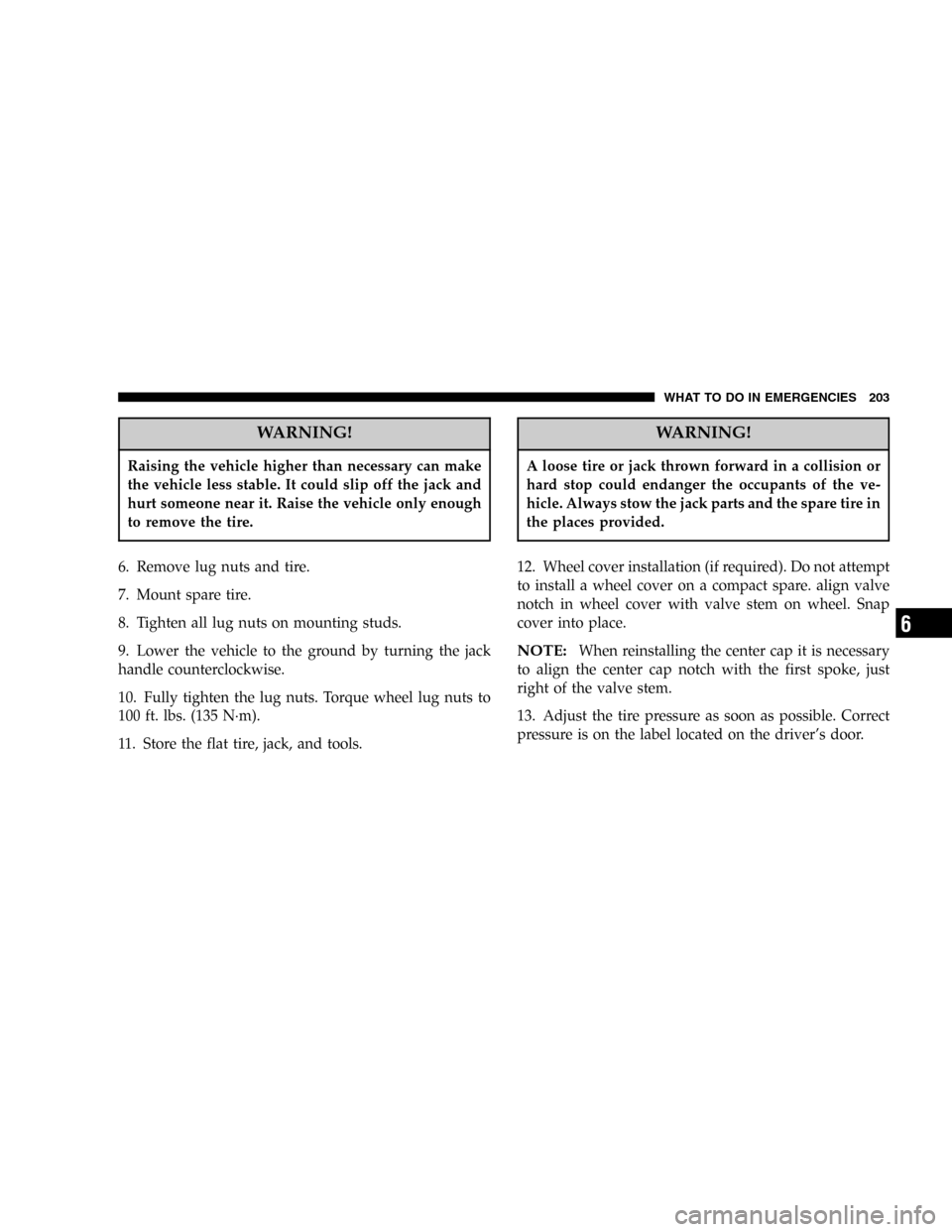Page 201 of 302
1. Block wheel diagonally op-
posite flat tire.
2. Remove the spare tire, scissors jack and lug wrench
from stowage.
3. Before raising the vehicle, use lug wrench to carefully
pry off wheel cover (if equipped with steel wheels) or
center cap (if equipped with aluminum wheels). Loosen,
but do not remove, the wheel nuts by turning them
counterclockwise one turn while the wheel is still on the
ground.
WARNING!
To avoid possible personal injury, handle the wheel
covers with care to avoid contact with the metal
edges and retention teeth.
4. Turn the jack screw clockwise to firmly engage the jack
saddle with the lift area of the sill flange. Use the lift area
closest to the flat tire
5. Raise the vehicle just enough to remove flat tire and
install spare tire.
Center Cap Removal
WHAT TO DO IN EMERGENCIES 201
6
Page 203 of 302

WARNING!
Raising the vehicle higher than necessary can make
the vehicle less stable. It could slip off the jack and
hurt someone near it. Raise the vehicle only enough
to remove the tire.
6. Remove lug nuts and tire.
7. Mount spare tire.
8. Tighten all lug nuts on mounting studs.
9. Lower the vehicle to the ground by turning the jack
handle counterclockwise.
10. Fully tighten the lug nuts. Torque wheel lug nuts to
100 ft. lbs. (135 N·m).
11. Store the flat tire, jack, and tools.
WARNING!
A loose tire or jack thrown forward in a collision or
hard stop could endanger the occupants of the ve-
hicle. Always stow the jack parts and the spare tire in
the places provided.
12. Wheel cover installation (if required). Do not attempt
to install a wheel cover on a compact spare. align valve
notch in wheel cover with valve stem on wheel. Snap
cover into place.
NOTE:When reinstalling the center cap it is necessary
to align the center cap notch with the first spoke, just
right of the valve stem.
13. Adjust the tire pressure as soon as possible. Correct
pressure is on the label located on the driver’s door.
WHAT TO DO IN EMERGENCIES 203
6
Page 209 of 302
TOWING THIS VEHICLE BEHIND ANOTHER
VEHICLE (Flat towing with all four wheels on the
ground)
Automatic Transaxle
Your vehicle may be towed under the following condi-
tions: The gear selector must be in NEUTRAL, the
distance to be towed must not exceed 15 miles (25 km),
and the towing speed must not exceed 25 mph (40
km/h). If the transaxle is not operative, or if the vehicle
is to be towed more than 15 miles (25 km), the vehicle
must be towed with the front wheels off the ground.
CAUTION!
If the vehicle being towed requires steering, the
ignition switch must be in the OFF position, not in
the LOCK or ACCESSORY positions.
If it is necessary to use the accessories while being towed
(wipers, defrosters, etc.), the key must be in the ON
position, not the ACCESSORY position. Make certain the
transaxle remains in NEUTRAL.
WHAT TO DO IN EMERGENCIES 209
6
Page 228 of 302

Fluid level should be maintained at the proper level
indicated on the side of the reservoir. If necessary, add
fluid to restore to the proper indicated level. With a clean
cloth, wipe any spilled fluid from all surfaces. Refer to
Fluids, Lubricants, and Genuine Parts for correct fluid
type.
Suspension Ball Joints
There are two upper front and rear suspension ball joints.
Inspect these ball joints whenever under vehicle service is
done. If the seals are damaged, the ball joint should be
replaced.
Body Mechanism Lubrication
Locks and all body pivot points, including such items as
seat tracks, doors, liftgate and hood hinges, should be
lubricated periodically to assure quiet, easy operation
and to protect against rust and wear. Prior to the appli-
cation of any lubricant, the parts concerned should be
wiped clean to remove dust and grit; after lubricating
excess oil and grease should be removed. Particular
attention should also be given to hood latching compo-
nents to insure proper function. When performing otherunderhood services, the hood latch, release mechanism
and safety catch should be cleaned and lubricated.
Hood Latch
When performing other under hood services, the hood
latch release mechanism and safety catch should be
inspected, cleaned, and lubricated.
It is important to maintain proper lubrication to insure
that the hood mechanisms work properly and safely.
Multi-Purpose Lubricant, NLGI Grade 2, should be ap-
plied sparingly to all pivot and sliding contact areas.
External Lock Cylinders
Lubricate the external lock cylinders twice a year, prefer-
ably in the fall and spring. Apply a small amount of
lubricant, such as Mopar Lock Cylinder Lubricant or
equivalent directly into the lock cylinder (avoid excess
lubricant). Insert the key into the lock cylinder and rotate
from the unlocked to the locked position; without adding
more lubricant. Repeat this procedure three or four times.
Wipe all the lubricant off the key with a clean cloth, to
avoid soiling clothing.
228 MAINTAINING YOUR VEHICLE
Page 229 of 302

If you use a lubricant that cannot be dispensed directly
into the lock cylinder, apply a small amount of the
lubricant to the key. Insert the key into the lock cylinder,
then proceed as described above, to distribute the lubri-
cant within the lock cylinder. Pay attention to trunk
hinges, especially during cold weather, to ensure ease of
trunk operation.
Other Body Mechanisms
The following body mechanisms should be inspected
and, if necessary, all pivot and sliding contact areas of
these components should be lubricated with the lubricant
specified as follows:
Engine Oil
•
Door hinges
•Hood hinges
•Trunk hinges
Smooth White Body Lubricant - Such as Mopar
Spray White Lube or equivalent:
•
Hood hinge springs and links
•Lock cylinders
•Parking brake mechanism
•Trunk latches
•Ash tray
Windshield Wiper Blades
Clean the rubber edges of the wiper blades and the
windshield periodically with a sponge or soft cloth and a
mild non abrasive cleaner. This will remove accumula-
tions of salt or road film.
Operation of the wipers on dry glass for long periods
may cause deterioration of the wiper blades. Always use
washer fluid when using the wipers to remove salt or dirt
from a dry windshield. Avoid using the wiper blades to
remove frost or ice from the windshield. Keep the blade
rubber out of contact with petroleum products such as
engine oil, gasoline, etc.
MAINTAINING YOUR VEHICLE 229
7
Page 230 of 302
Windshield Wiper Blade Replacement
•
Lift the wiper arm away from the glass.
•Push the release tab and slide the wiper blade assem-
bly away from the wiper arm. Gently place the wiper
arm on the windshield.
•Install the new blade assembly onto the wiper arm tip
until it locks in place.
Windshield Washers
The fluid reservoir in the engine compartment should be
checked for fluid level at regular intervals. Fill the
reservoir with windshield antifreeze (not radiator anti-
freeze) rated not to freeze at -25°F (-31°C). Operate the
system for a few seconds to flush out the residual water.
WARNING!
Commercially available windshield washer solvents
are flammable. They could ignite and burn you. Care
must be exercised when filling or working around
the washer solution.
Washer Fluid Reservoir
230 MAINTAINING YOUR VEHICLE
Page 249 of 302
Cavity Fuse Circuit
1 30 Amp
GreenBlower Motor
2 10 Amp Red Right High Beam Head-
light, High Beam Indica-
tor
3 10 Amp Red Left High Beam Head-
light
4 15 Amp
BluePower Door Lock Switch
Illumination, Power Top
Switch, Transmission
Range Switch, Daytime
Running Light Module
(Canada), Power Win-
dows, Anti-lock Brake
System ModuleCavity Fuse Circuit
5 10 Amp Red Power Door Lock and
Door Lock Arm/Disarm
Switches, Vanity, Read-
ing, Map, Rear Seating,
Ignition, and Trunk
Lights, Illuminated Entry,
Radio, Power Antenna,
Data Link Connector,
Body Control Module,
Power Amplifier
6 10 Amp Red Heated Rear Window
Indicator
7 20 Amp Yel-
lowInstrument cluster illumi-
nation, Park and tail
Lights
8 20 Amp Yel-
lowPower Receptacle, Horns,
Ignition, Fuel, Start
9 15 Amp
BluePower Door Lock Motors
(Body Control Module)
10 20 Amp Yel-
lowDaytime Running Light
Module (Canada)
MAINTAINING YOUR VEHICLE 249
7
Page 252 of 302
3. Gently pry the headlight assembly away from the
fender as shown in the picture. This will free the ball stud
from its retainer in the fender. Pull the headlight assem-
bly away from the vehicle.4. Turn the retaining ring counterclockwise and remove
the bulb and socket assembly.
252 MAINTAINING YOUR VEHICLE